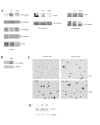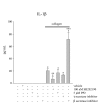Adhesion of monocytes to type I collagen stimulates an APP-dependent proinflammatory signaling response and release of Abeta1-40
- PMID: 20302643
- PMCID: PMC2850892
- DOI: 10.1186/1742-2094-7-22
Adhesion of monocytes to type I collagen stimulates an APP-dependent proinflammatory signaling response and release of Abeta1-40
Abstract
Background: Amyloid precursor protein (APP) is a ubiquitously expressed cell surface protein reported to be involved in mediating cell-cell or cell-matrix interactions. Prior work has demonstrated that APP co-localizes with beta1 integrin in different cell types.
Methods: In an effort to determine the function of APP on monocytic lineage cells, in particular, the human monocyte cell line, THP-1, was used to assess the role of APP during adhesion to the extracelluar matrix component type I collagen.
Results: Pull-down assays demonstrated that THP-1 adhesion to collagen stimulated a tyrosine kinase-associated signaling response which included subsequent phosphorylation of p38 MAP kinase and increased association of APP with alpha2beta1 integrin, specifically. In addition, cell adhesion was dependent upon APP expression since APP siRNA knockdown attenuated THP-1 adhesion to collagen compared to mock transfected controls. One consequence of the tyrosine kinase-dependent signaling response was increased secretion of interleukin-1beta (IL-1beta) and Abeta1-40 but not the Abeta1-42 fragment of APP. Increased secretion of IL-1beta was dependent upon p38 MAP kinase activity while Abeta1-40 secretion required Src family kinase activity since the specific p38 inhibitor, SB202190, and the Src family kinase inhibitor, PP2, attenuated IL-1beta and Abeta1-40 secretion, respectively.
Conclusions: These data demonstrate that APP is involved in classic integrin-dependent tyrosine kinase-associated adhesion and activation of peripheral monocytic cells. Moreover, divergent APP-dependent signaling is required for increased secretion of both IL-1beta and Abeta1-40 as a component of the adhesion-dependent change in phenotype. This suggests that APP may have a broad role in not only mediating cell-matrix adhesion but also in the function of peripheral immune cells.
Figures





References
-
- Scheuner D, Eckman C, Jensen M, Song X, Citron M, Suzuki N, Bird TD, Hardy J, Hutton M, Kukull W. Secreted amyloid beta-protein similar to that in the senile plaques of Alzheimer's disease is increased in vivo by the presenilin 1 and 2 and APP mutations linked to familial Alzheimer's disease. Nat Med. 1996;2:864–70. doi: 10.1038/nm0896-864. - DOI - PubMed
Publication types
MeSH terms
Substances
Grants and funding
LinkOut - more resources
Full Text Sources
Miscellaneous

